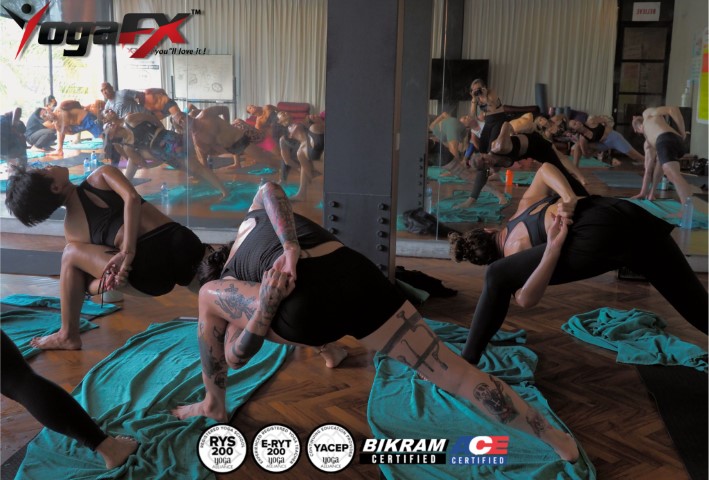Hot yoga and regular yoga are both renowned practices that offer a multitude of benefits for the mind, body, and spirit. While they share the same roots, there are distinct differences between the two, mainly attributed to the element of heat. Hot yoga, performed in a heated room, and regular yoga, practiced in a standard temperature environment, each provide unique advantages. In this article, we will dive into the benefits of hot yoga versus regular yoga, exploring how the added element of heat can enhance your practice and elevate your overall well-being. Whether you prefer to embrace the warmth or find solace in the familiar, both paths offer transformative experiences on the mat. So, roll out your mat, embrace the heat, and discover the unique advantages that hot yoga and regular yoga bring to your practice.

Benefits of Hot Yoga
1. Improved Flexibility and Increased Range of Motion
The heat in hot yoga studios warms up muscles, tendons, and ligaments, allowing for deeper stretches and increased flexibility. Practitioners often find that the heat helps release tension and enables them to explore new depths in their postures.
2. Enhanced Detoxification and Release of Toxins
The intense sweating induced by hot yoga promotes detoxification by flushing out impurities and toxins from the body. This cleansing process rejuvenates the organs and leaves you feeling refreshed and revitalized.
3. Intensified Calorie Burning and Potential for Weight Management
The combination of heat and vigorous movement in hot yoga can elevate your heart rate, leading to increased calorie burn. Regular hot yoga practice, coupled with a balanced diet, can contribute to weight management goals.
4. Increased Cardiovascular Health and Improved Stamina
The elevated temperature in hot yoga classes creates a cardiovascular workout, challenging the heart and improving its strength. Regular participation in hot yoga can enhance cardiovascular health, increase endurance, and boost overall stamina.
5. Deepened Mind-Body Connection and Improved Mental Focus
The heat in hot yoga classes intensifies the mind-body connection, requiring practitioners to be fully present and focused. The practice cultivates mental clarity, concentration, and mindfulness, allowing you to experience a deeper sense of self-awareness.
“Respond To Your Plan Failure To Believe In Your Plan”
Benefits of Regular Yoga
1. Improved Flexibility and Increased Range of Motion
Regular yoga practice, regardless of temperature, promotes flexibility and improves range of motion. The combination of stretching, lengthening, and holding poses helps release muscle tension and enhances overall mobility.
2. Promotion of Relaxation, Stress Reduction, and Improved Mental Well-being
Regular yoga classes, with their emphasis on breathwork, meditation, and gentle movements, induce a sense of calm and relaxation. This practice reduces stress, anxiety, and promotes mental well-being.
3. Development of Strength and Toning
Regular yoga incorporates various poses and movements that engage different muscle groups, leading to improved strength and toning. The integration of bodyweight resistance helps build lean muscle and enhances overall body strength.
4. Improved Balance, Posture, and Alignment
Through a focus on proper alignment and balance, regular yoga practice helps improve posture and stability. Strengthening the core muscles and increasing body awareness contribute to better alignment both on and off the mat.
5. Enhanced Breath Control and Mindfulness
Regular yoga classes emphasize conscious breathing techniques, such as deep belly breaths and pranayama exercises. These practices improve breath control, enhance oxygenation of the body, and foster a deeper connection between breath, body, and mind.

Comparing the Benefits: Hot Yoga vs. Regular Yoga
While both hot yoga and regular yoga offer numerous benefits, there are some notable differences. Hot yoga, with its elevated temperature, intensifies certain aspects of the practice, such as flexibility, detoxification, and cardiovascular challenge. On the other hand, regular yoga, regardless of the temperature, emphasizes relaxation, stress reduction, and mindfulness. Choosing between the two depends on personal preferences, fitness goals, and the desired experience on the mat. Some practitioners thrive in the heat, while others find solace in the serenity of a regular yoga practice.
Finding the Right Practice for You
1. Assessing Personal Preferences and Fitness Goals
Consider your preferences regarding heat, physical intensity, and mental focus. Reflect on your fitness goals, whether they involve flexibility, strength, stress reduction, or overall well-being. This self-reflection will help guide you towards the practice that aligns with your individual needs.
2. Seeking Professional Guidance and Trying Different Classes
If you are unsure which practice suits you best, seek guidance from experienced yoga instructors. Attend a variety of hot yoga and regular yoga classes to experience firsthand the differences and benefits of each practice. Trying different styles and studios will allow you to explore and find your preferred approach to yoga.
YogaFX Bikram Hot Yoga Teacher Training Online Offer
Are you passionate about hot yoga and considering becoming a certified hot yoga teacher? YogaFX offers an immersive and comprehensive online Bikram hot yoga teacher training program. This training equips you with the knowledge and skills to teach the renowned 26 and 2 yoga series. With YogaFX’s online platform, you can embark on your journey to become a certified hot yoga teacher from the comfort of your own home. Visit YogaFX’s website to learn more about their online Bikram hot yoga teacher training and start your transformational journey today.

Conclusion
Hot yoga and regular yoga offer unique benefits to practitioners, enhancing flexibility, promoting relaxation, and improving overall well-being. Whether you prefer to immerse yourself in the heat of hot yoga or find tranquility in regular yoga, both paths provide opportunities for growth and self-discovery. Embrace the warmth or embrace the familiar—find the practice that resonates with you, and let your yoga journey unfold. Remember, whether online or in a studio, hot yoga or regular yoga, the mat is your sanctuary for self-care, exploration, and finding your flow.

